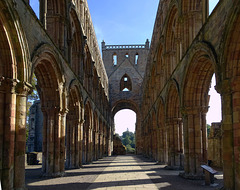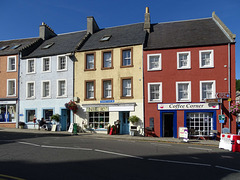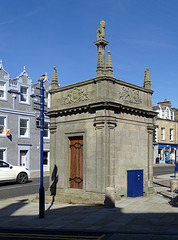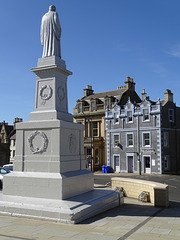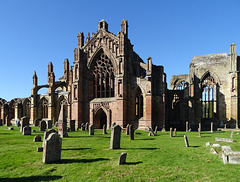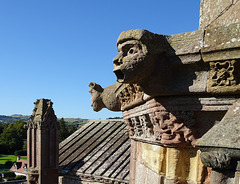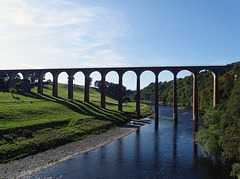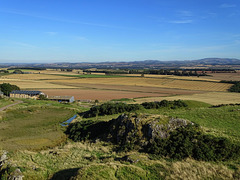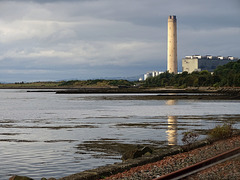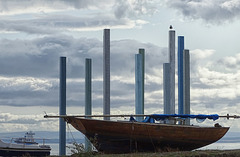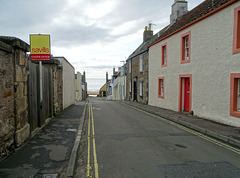
SCOTLAND
Jedburgh Abbey Ground Floor
| |
|
|
|
Jedburgh Abbey, a ruined Augustinian abbey which was founded in the 12th century, is situated in the town of Jedburgh, in the Scottish Borders.
The foundation appeared to have the status of 'priory' in the early years and a man by the name of Daniel was described as the Prior of Geddwrda in 1139. The church was later raised to the status of monastery before becoming, in the years prior to King David's death in 1153, a fully fledged abbey dedicated to the Virgin Mary, probably in 1147.
Abbey Arches
| |
|
|
|
Coffee Corner
| |
|
|
|
As one gets older then the first thing to do when visiting an area is to find a coffee shop with a loo.
View of the North Sea from St.Andrews Castle
| |
|
|
|
Selkirk. The Pant Well
| |
|
|
|
On 2 sides of this building there is a drinking fountain. The Pant Well takes its name from the granite overflow trough (pant) which was added in 1715 and provided a water supply for animals.
I thought it was the market cross until I started looking closely at my photos.
Sir Walter Scott views Selkirk
| |
|
|
|
The statue of Sir Walter Scott stands in Selkirk's Market Place outside the courtroom where Sir Walter Scott sat as Sheriff of Selkirk from 1804 till 1832. The courtroom is now a museum which explores Scott's life, his writings and his time as Sheriff. The statue was unveiled by the Duke of Bucleugh in 1839.
The pedestal includes the heraldic emblem of Scott, the arms of Selkirk, a winged harp and a Scots thistle.
The mandatory coffee shop and loo is just behind where I'm standing.
Melorose Abbey
| |
|
|
|
St Mary's Abbey, Melrose is a partly ruined monastery of the Cistercian order in Melrose, Roxburghshire, in the Scottish Borders. It was founded in 1136 by Cistercian monks at the request of King David I of Scotland, and was the chief house of that order in the country until the Reformation.
Courtesy of Wikipedia: www.google.com/search?client=firefox-b-d&q=Melrose+abbey+history
It was largely destroyed by Richard II's English army in 1385.
Melrose Abbey Gargoyles
| |
|
|
|
In architecture, a gargoyle is a carved or formed grotesque with a spout designed to convey water from a roof and away from the side of a building, thereby preventing rainwater from running down masonry walls and eroding the mortar between.
en.wikipedia.org/wiki/Gargoyle
Shadows and reflections
| |
|
|
|
The Leaderfoot Viaduct, also known as the Drygrange Viaduct, is a railway viaduct over the River Tweed near Melrose in the Scottish Borders. The viaduct is in good condition, having been renovated between 1992 and 1995. To the east of the viaduct is the Drygrange Old Bridge, dating from 1776, on which I was standing to take this photo. It is no longer used by traffic and has been superseded by a newer road bridge.
en.wikipedia.org/wiki/Leaderfoot_Viaduct
Smailholm Peel Tower
| |
|
|
|
In the Scottish borders a line of Peel towers was built in the 1430s across the Tweed valley from Berwick to its source, as a response to the dangers of invasion from the Marches. Sited high on a rocky outcrop, Smailholm is a small rectangular tower set within a stone barmkin wall. This 65 ft (20 metre) towerhouse was built by the Pringle family.a well-known Scottish Borders family. In common with all Scottish peel towers, it was built to provide its occupants with protection from sporadic English raids. Today you can enjoy stunning views of the surrounding countryside from Smailholm Tower’s battlements.
The last owner, the Earl of Ellesmere, handed the property into state care in 1950. It was restored in the 1980s, and now operates as a museum for Historic Scotland. We were very impressed with this site. It's beautifully maintained and the history is interesting.
The PiP shows the view of the Scottish borders from the battlements.
View of the Scottish borders from Smailholm Tower.
| |
|
|
|
HFF to you all.
Newhaven Harbour.
| |
|
|
|
Longannet Power station
| |
|
|
|
At the time of opening in the early 1970s Longannet was the largest power station in Europe with a capacity of 2,400 MW. Designed by Scottish architects Robert Matthew, Johnson Marshall & Partners, construction began in 1965 on land reclaimed from the Firth of Forth using ash from the Kincardine power station. The first electricity was generated in 1970 and the station was running at full capacity by 1973 once construction of all units was complete.
In 2003 Longannet was identified as Scotland’s largest source of pollution. The power station closed in 2016 after 46 years of producing electricity. The closure marked the end of coal-fired generation in Scotland.
Courtesy of: www.powerstations.uk/longannet-power-station-fife-scotland
The power station is gradually being demolished. See below for video.
Longannet Power Station Annex Demolition
The tower was finally demolished yesterday. www.bbc.co.uk/news/av/uk-scotland-59597883
The Harbourmaster's House. Dysart
| |
|
|
|
High and Dry in Dysart
| |
|
|
|
Behind the boat is an outdoor sculpture called 'Sea Beams' by Donald Urquhart, comprised of nine vertical oak beams illustrating the different colours of the sea.The Firth of Forth can be seen behind it here. The oak beams were each cut from a single tree.
High and Dry in Elie
I must go down to the seas again.
| |
|
|
|
Jump to top
RSS feed- Latest items - Subscribe to the latest items added to this album
- ipernity © 2007-2024
- Help & Contact
|
Club news
|
About ipernity
|
History |
ipernity Club & Prices |
Guide of good conduct
Donate | Group guidelines | Privacy policy | Terms of use | Statutes | In memoria -
Facebook
Twitter

